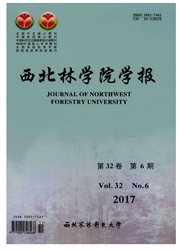

 中文摘要:
中文摘要:
以贵阳市环城高速南环线经人工植被恢复的3个石质边坡为研究对象,采用常规群落调查法,对其进行3a的定期定位观测。结果表明:调查中共记录51种植物,分属13科43属,其中主要为禾本科、豆科、菊科3大科植物;群落物种数量组成具明显季节性,最大值出现在每年8月或9月,最小值出现在每年2月;群落物种组成有所改变,禾本科植物比例逐年下降,豆科植物在干旱低温胁迫期所占比例最高,表现出良好的适应能力;群落优势种发生改变,由初期的多年生草本植物占绝对优势地位,逐步向乔灌草共存的方向演替;植被群落丰富度指数、Shannon-Wiener指数、Pielou均匀度指数呈直线上升趋势。同时,试提出一种植物配置模式,为今后黔中喀斯特地区公路边坡恢复植物配置提供参考。
 英文摘要:
英文摘要:
In order to understand the detailed features of the community changes after the vegetations were planted in rocky slopes, and to analyze the potential trends of the artificial vegetation community succession, this paper took three rocky slopes along the south loop in Guiyang as the research objects, using the conventional community survey method to carry out the regular survey for 3 years. The results showed that totally 51 kinds of plants in the investigation were recorded, belonging to 43 genera and 13 families, mainly Gramineae, Leguminosae, and Compositae plants. Species composition exhibited obvious seasonal changes. Community species quantitative composition showed seasonal changes and the maximum number of the plant species was observed in August or September every year. The minimum was in February. Community species composition also changed, Gramineae percentage declined year by year. During the stress period of drought and low temperature, Leguminous plants occupied the highest proportion, showed a good ability to adapt the stresses. The community dominant species changed by perennial herbaceous plants in the early dominant position, gradually towards the coexistence of halosols desert succession. Vegetation richness index, Shannon Wiener diversity index and Pielou evenness index increased linearly. A kind of plant configuration mode was put forward to provide a reference for the plant configuration along the highway slope recovery in Guizhou Karst area in the future.
 同期刊论文项目
同期刊论文项目
 同项目期刊论文
同项目期刊论文
 期刊信息
期刊信息
